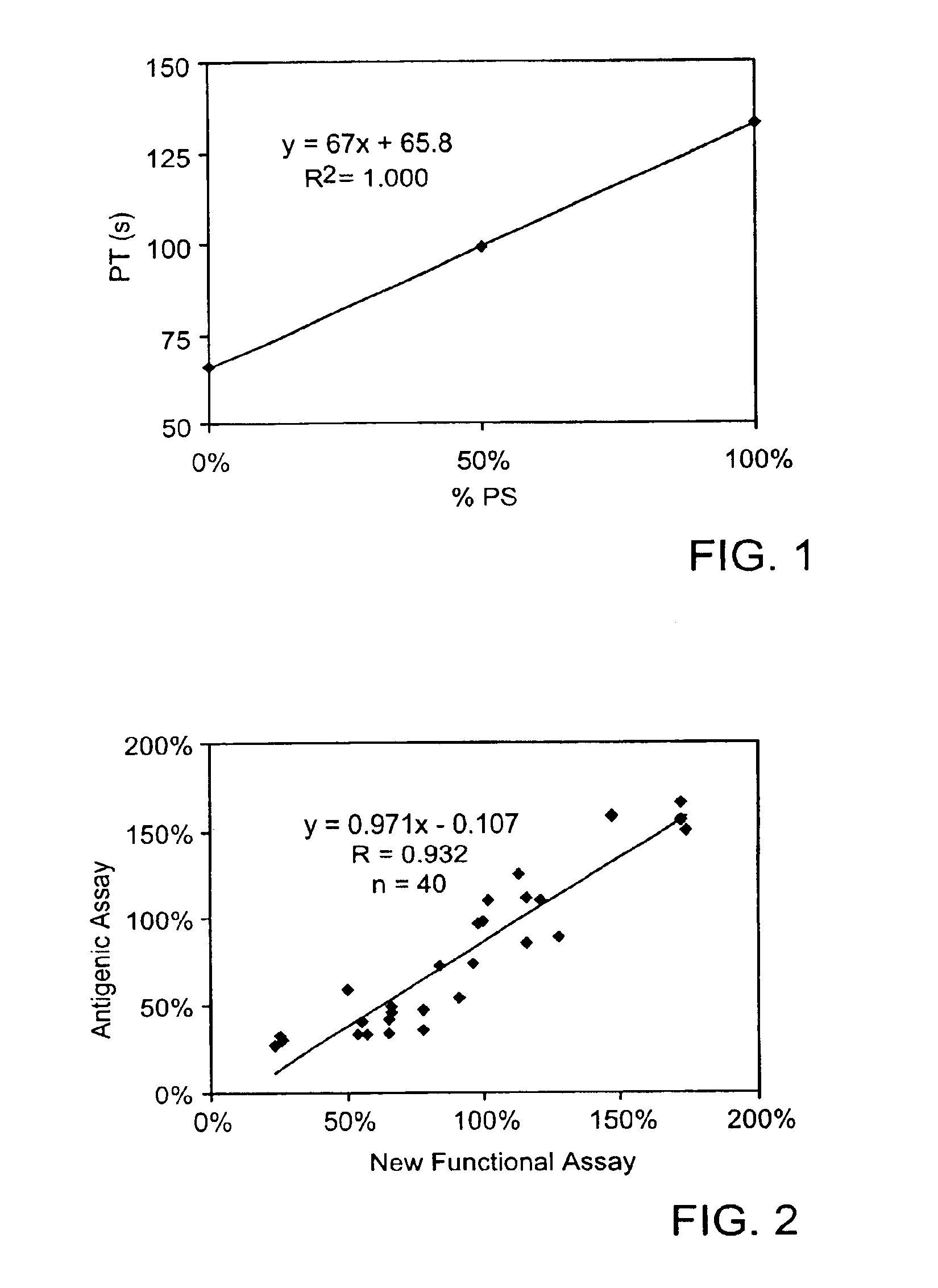Protein S functional assay and kit therefor
a functional assay and protein technology, applied in the field of can solve the problems of increased risk of thrombosis, complicated functional protein s assays, and poor reproducibility of traditional protein s functional assays
- Summary
- Abstract
- Description
- Claims
- Application Information
AI Technical Summary
Benefits of technology
Problems solved by technology
Method used
Image
Examples
example 1
Preparation of Phospholipids by Extrusion
PLs micelles were prepared by extrusion. In this method, PLs are first suspended in a buffered saline solution to give large, multilamellar vesicles. The vesicle solution, e.g., 0.5-1.0 mls, is then passed through a 0.45 μm polycarbonate membrane and repeatedly passed through a 0.1 μm polycarbonate membrane six times. The result is uniformly sized, unilamellar vesicles, approximately 100 nm in diameter. The extrusion process is performed using, for example a LiposoFast-100 Extruder (Avestin, Inc., Ottawa, Canada). The LiposoFast-100 is a medium pressure extruder that uses compressed gas (e.g., nitrogen) at up to 600 PSI to pressurize the sample cylinder and force the starting material through the membrane. The extruded PL is then added to TF, which attaches to the outside of the lipid vesicle.
Extrusion may be performed according to standard methods or according to the manufacturer's recommendations, e.g., the method of http: / / tf7.org / methods....
example 2
Purification of TF from Cell Lysates
Tissue factor (TF) is purified from cell lysates using the following method. Cells producing TF are washed with TBS and resuspended to 2×107 / ml in TBS containing 0.25% Triton-X100, 10 μg / ml soybean trypsin inhibitor, and 1 mM EDTA. After incubation for 30 min at 4° C., the cellular debris is removed by centrifuging for 20 min at about 5000×g at 4° C. The clarified lysate is diluted 2.5-fold with TBS to reduce the Triton concentration to 0.1% and passed through an immunoaffinity resin containing a covalently coupled monoclonal antibody directed against TF. The resin bed is washed with 2 to 3 bed volumes of TBS+0.1% Triton-X100, 2 to 3 volumes 20 mM Tris, pH 7.5, 0.5 M NaCl, 0.1% Triton-X100, and finally 2 to 3 bed volumes 0.5 M NaCl, 0.1% Triton-X100. The bound protein is eluted from the resin with 0.1 M glycine, pH 2.5, 0.1% Triton-X100. Fractions collected after the buffer was changed to glycine are neutralized immediately with an appropriate vol...
example 3
Tissue Factor Relipidation Using Detergent
This technique for incorporating TF into PL vesicles uses the dialyzable, non-ionic detergent, n-octyl-beta-D-glucopyranoside (octylglucoside) (Calbiochem Corp., La Jolla, Calif.). (http: / / tf7.org / methods.html; Neuenschwander et al. (1993) J. Biol. Chem. 268:21489-21492) (see also U.S. Pat. No. 6,203,816, the contents of which are incorporated herein by reference).
In this method, PLs and TF are both dissolved in octylglucoside, forming mixed micelles. Since octylglucoside has a high critical micelle concentration (CMC=20 to 25 mM), it can readily be removed from solutions by dialysis. As the octylglucoside dialyses out, the phospholipids organize into unilamellar vesicles. TF becomes embedded in these vesicles by virtue of its single membrane-spanning domain, located near the C-terminus of the protein. Typically, about 50 to 80% of the TF molecules face outward in these vesicles. The remaining TF molecules face inward and are therefore unabl...
PUM
| Property | Measurement | Unit |
|---|---|---|
| concentration | aaaaa | aaaaa |
| concentration | aaaaa | aaaaa |
| molar ratio | aaaaa | aaaaa |
Abstract
Description
Claims
Application Information
 Login to View More
Login to View More - R&D
- Intellectual Property
- Life Sciences
- Materials
- Tech Scout
- Unparalleled Data Quality
- Higher Quality Content
- 60% Fewer Hallucinations
Browse by: Latest US Patents, China's latest patents, Technical Efficacy Thesaurus, Application Domain, Technology Topic, Popular Technical Reports.
© 2025 PatSnap. All rights reserved.Legal|Privacy policy|Modern Slavery Act Transparency Statement|Sitemap|About US| Contact US: help@patsnap.com

